- The Vultee Aircraft
Company
|

|
- Gerard "Jerry" Freebairn Vultee (1900-1938).
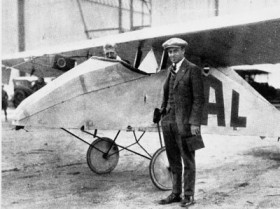 In 1912 his family
moved to Ocean Park, California, and he attended Caltech from
1921 to 1923, studying aviation science. As a student project
he designed and built a full-sized aircraft, the Tal Glider (
Photo right). In 1912 his family
moved to Ocean Park, California, and he attended Caltech from
1921 to 1923, studying aviation science. As a student project
he designed and built a full-sized aircraft, the Tal Glider (
Photo right).
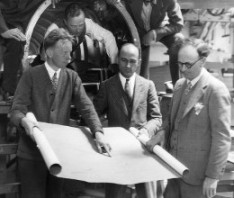 In
1923, Art Mankey, who was then in charge of engineering at Douglas
Aircraft, hired Vultee as a structural aeronautical engineer
( Jerry Vultee in Vega fuselage, 1929 photo at left). Also at
Douglas was Jack Northrop who was working on an idea for a commercial
aircraft, the Vega (Photo left). Since Douglas was doing military
aircraft at the time, Northrop took his idea to mentor Alan Loughead
(spelling later changed to "Lockheed.", photo left
of Bill Henry in middle and Lockheed at right). In
1923, Art Mankey, who was then in charge of engineering at Douglas
Aircraft, hired Vultee as a structural aeronautical engineer
( Jerry Vultee in Vega fuselage, 1929 photo at left). Also at
Douglas was Jack Northrop who was working on an idea for a commercial
aircraft, the Vega (Photo left). Since Douglas was doing military
aircraft at the time, Northrop took his idea to mentor Alan Loughead
(spelling later changed to "Lockheed.", photo left
of Bill Henry in middle and Lockheed at right).
In 1928, Northrop invited Vultee to join him and 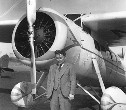 they
built the Vega, one of the most popular planes of its day. Wiley
Post, Amelia Earhart and Charles Lindbergh all flew and adored
it. (Wiley Post right). they
built the Vega, one of the most popular planes of its day. Wiley
Post, Amelia Earhart and Charles Lindbergh all flew and adored
it. (Wiley Post right).
In 1928, Northrop left the young company, and Vultee became
Lockheed's new chief engineer. He designed the Lockheed 8 Sirius
for Charles Lindbergh which brought him some notoriety.
Some of the innovations he helped introduce were the engine
nacelle or cowling, the fully retractable landing gear, replaceable
fuselage panels, the V-type windshield, and Vultee large wing
flaps that made it possible to reduce landing speeds.
But genius was not enough in the face of the Great Depression.
Controlling interest in Lockheed was purchased by the Detroit
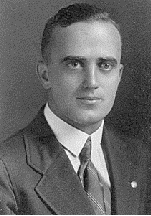 Aircraft Corporation.
In 1931 it went into receivership, and Vultee was replaced as
chief engineer by Richard Von Hake. Vultee accepted a job developing
and teaching drafting and engineering courses at the Curtiss-Wright
Technical Institute. He also took a post as chief engineer for
the E.M. Smith Corporation (EMSCO) in Downey. But the Depression
smothered new designs at EMSCO as well and he left, but eventually
he went off on his own in pursuit of financial backing for some
ideas that he and Vance Breese had for a single-engine six passenger
monoplane V-1 (V for Vultee). Aircraft Corporation.
In 1931 it went into receivership, and Vultee was replaced as
chief engineer by Richard Von Hake. Vultee accepted a job developing
and teaching drafting and engineering courses at the Curtiss-Wright
Technical Institute. He also took a post as chief engineer for
the E.M. Smith Corporation (EMSCO) in Downey. But the Depression
smothered new designs at EMSCO as well and he left, but eventually
he went off on his own in pursuit of financial backing for some
ideas that he and Vance Breese had for a single-engine six passenger
monoplane V-1 (V for Vultee).
- Vultee's search ended when he met Errett Lobban Cord in September
1931. Cord, the head of the Cord Corporation, owned two aviation
companies, Stinson Aircraft and Lycoming Motors, two automobile
companies, Auburn and Dusenberg, and five other engine manufacturers.
In early 1931, Cord had founded two airlines and he saw Vultee's
high-speed transport as a replacement for the Stinson tri-motors
these airlines were operating. In January 1932, Cord formed the
Airplane Development Corporation as a subsidiary of the Cord
Corporation, with Vultee as chief engineer, to begin work on
the Vultee V-1 transport. The company initially used a hangar
in Burbank, California. The V-1 was a popular aircraft, and American
Airways ordered ten. Completed as a prototype in 1933, it was
the fastest plane of its kind with a top speed of 235 mph. When
modified by American Airways it was known as the V-1A. The federal
government's regulation of civil aviation, created an unexpected
reversal of fortune by ruling that all commercial passenger planes
be Multi-engine. The V-1A was single engine, and was thus grounded
for passenger use.
In early 1932, Cord faced labor problems with his airlines pilots
and he sold both airlines to American Airways in exchange for
seven percent of the stock of American's parent company, the
Aviation Corporation. By late 1932, Cord had purchased 30 percent
of the stock in the Aviation Corporation and after a bitter stockholder's
battle, Cord gained control of the company.
|
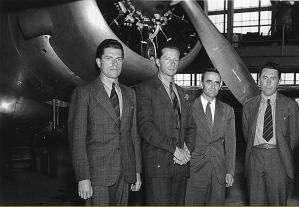
- Gerald Vultee, second from right, July 1937
|
The U.S. Congress passed the Air Mail Act of 1934 which prohibited
any air mail contractor from holding an interest in any other
aviation enterprise except landing fields. The result was that
the Aviation Corporation was required to divest American Airways
which was promptly renamed American Airlines. Another result
was that the Cord companies were restructured, i.e., the Aviation
Manufacturing Company was formed as a division of the Aviation
Corporation (AVCO) and the corporate hierarchy was now the Aviation
Company-Aviation Manufacturing Company-Airplane Development Company.
(Note that none of these companies were named Vultee.) Gerard
Vultee was named vice president and chief engineer of the Aviation
Manufacturing Company and work began on an attack bomber for
export. The facilities at Glendale proved too small for production
and the company moved to an abandoned plant in Downey, California
in June 1936. |
- E.L. Cord sold his interests in the Aviation Corporation
to a syndicate in 1937 which resulted in a number of corporate
reorganizations. In November 1937, Vultee was reorganized as
the Vultee Aircraft Division of the Aviation Manufacturing Corporation;
this was the first time that a independent company was named
Vultee.
-
- Vultee aircraft sold well overseas, with 1,500 employees
and more than a million dollars in orders for V-1s, V-1As and
V-11s, the U.S. Army Air Corps (USAAC) had ignored their aircraft,
On Saturday, January 29, 1938 Jerry and Sylvia Vultee were flying
home from Washington, D.C. in his personal Stinson Reliant SR-9C
cabin monoplane, registration number NC17159, after presenting
a new aircraft design to the Army. The venerable 1936 Stinson
Reliant was popular at the time and featured leather upholstery,
walnut instrument panels, and automobile-style roll-down windows.
The Stinson Reliant was a rugged aircraft built of fabric-covered
welded steel-tubing structures with a single strutbraced double-tapered
wing. Powered by a 260hp Lycoming R-680 radial engine, the Reliant
carried a pilot plus three or four passengers at speeds close
to 165 miles per hour. Pilots appreciated the Reliant's durability,
safety, and stability in flight, while passengers enjoyed a comfortable
ride in an opulent cabin. The couple was anxious to return to
their six month old son and home in Glendale California. They
departed the TWA Winslow Arizona Airport at 8:35 in the morning
and were headed west to Downey California when they were caught
in a snowstorm and blizzard. Jerry Vultee was an excellent pilot
but had no training in instrument flying and it is believed that
he was unable to find his way out of the blinding snow storm.
He most likely became disorientated and loss direction. The aircraft
disappeared approximately two hours after taking off. Local Oak
Creek Canyon ranchers heard the plane flying a crisscross pattern
apparently lost in the snow storm trying to find a break in the
clouds and then crash. The rancher’s accurate description
gave searchers a good direction in which to search, narrowing
down the search area. Forest Rangers, Civilian Conservation Corps
(C.C.C.) workers and over a hundred hunters were involved in
the search. Thickly wooded terrain covered by at least 1 ½
feet of snow proved difficult for the searchers. The search continued
for hours until darkness closed in and had to be abandoned. The
next day it was announced that a $500 hundred dollar reward was
offered by the Vultee Company for finding the plane and passengers.
Additionally, five Army planes from March Field California also
joined in to help in the search. The wreckage was discovered
by a Forest Ranger and a couple of C.C.C. workers about noon
Sunday, January 30 after an extensive search. Witnesses said
that the plane wreck was a terrible sight; little was left of
the plane except a heap of twisted and blackened metal. A small
branch of a nearby tree had broken off showing that the plane
had come in from the west. The aircraft had slammed into the
snow covered ground, about three miles north of Mount Wilson
between Sedona and Flagstaff, Arizona. The impact site was only
a couple hundred feet from the edge of a deep rocky chasm. The
propeller had dug into the ground, breaking off and burying one
blade. The plane was found inverted facing west and badly burned.
Pieces of the engine and unburned debris were found hurled almost
to the brink of the canyon leading to the conclusion that there
was no pre-crash fire. The exact cause of the crash has never
been determined. The opinion at the time was that the pilot was
headed east when the aircraft nosed into the ground and that
flames closely followed the crash. It was also believed that
the two were fatally injured by the crash and not killed by the
flames. Mrs. Vultee was identified by her jewelry and several
pieces were recovered and returned to the family. Gerald Vultee’s
wrist watch had stopped at 9:56 a.m. Two young promising lives
were cut short, Gerald Vultee was only 38 at the time and his
wife Sylvia Vultee was 27. A bronze plaque memorializing the
Vultees is located at the end of Coconino Forestry trail named
in honor of Vultee Arch, a natural rock arch near the site of
the plane crash. Jerry Vultee's close friend and Vice President
of Vultee wrote a letter to TIME magazine about Jerry's death:
-
- Sirs:
- Gerard F. Vultee ("Jerry"), not Gerald, my close
friend and business associate for many years, was killed when
the cabin monoplane he was flying with Mrs. Vultee crashed on
the flat top of Wilson Mountain [TIME, Feb. 7].... Caught in
a local snow-storm and blizzard with no training in blind or
instrument flying, he was unable to find his way out. The fire
occurred after the crash, not before.
- DON P. SMITH Vice President
-
- Jerry Vultee was succeeded as president and general manager
of the Vultee plant by Richard Palmer who became chief engineer
in 1940, and the plant was named Vultee Aircraft. A new plane
known as the V-12-C was ordered by the Chinese who took 26 in
1939. And the U.S. government ordered training planes in a contract
worth $2,986,000 with Vultee in August of the same year. The
plant was redesigned to meet the new production demands.
-
- In 1939, Stinson Aircraft became a division of Vultee and
on 14 November 1939, Vultee Aircraft, Incorporated was established
to acquire the assets of the Aviation Manufacturing Company making
Vultee a subsidiary of the parent company, the Aviation Company.
The next major reorganization occurred in November 1941 when
Vultee acquired majority ownership of the Consolidated Aircraft
Corporation. Two boards of directors, headed by the same person,
were maintained to control the two companies but this changed
on 17 March 1943 when the two companies merged and were renamed
the Consolidated Vultee Aircraft Corporation with headquarters
in San Diego, California. Stinson remained a division of the
new company.
-
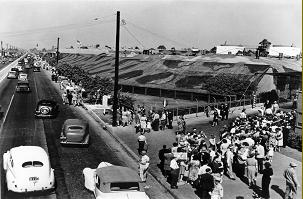
By 1940 the plant had doubled in size. As World War II approached,
activity at the Vultee plant, in both production and personnel,
continued to increase. To protect the plant from possible enemy
detection, most of the buildings were camouflaged to appear like
surrounding farmland and orange groves. An antiaircraft gun was
also emplaced on the roof of Building 1 to support antiaircraft
operations that occurred near Paramount and 3rd Streets. Crosswalks
were also built across Lakewood Blvd. to assist thousands of
workers as they crossed the busy street. During the early 1940's
the Vultee Valiant Basic Trainer was produced for the Army Air
Corps.
Vultee was the first major manufacturing plant to use powered
assembly lines producing more planes in a shorter span of time
than any other similar plant.
- In numbers of planes, the BT-13
Valiant Basic trainer represented the largest order ever placed
by the Army Air Corps. By July 1941, Vultee was producing 15
percent of all the military aircraft in the nation. The company
received enormous military contracts to construct these basic
training planes for Army, Navy, and Marine pilots; many of Downey's
men went off to war; and hundreds of women joined the Vultee
workforce. Vultee was the first military aircraft manufacturer
to employ women directly in production. Women received exactly
the same pay for equivalent work as men. Vultee's particular
masterpiece is what executives exultantly describe as the first
and truly powered assembly line in the industry. It consists
of an overhead oval track, located at the head of the final assembly,
from which dangle twenty-five cradles fed with raw fuselage frames.
-
- 1942-1948 Consolidated Vultee Aircraft Corporation (Convair)
brought together Consolidated Aircraft of San Diego and Vultee
of Downey, California. Practically every type of military aircraft
from small, single engine, civilian defense trainers to huge,
multiple engine land and sea bombers were produced in the diversified
plants of the companies. 11,537 trainer aircraft (Valiants) had
been produced at the Vultee field. Also, in the first 6 months
of 1944, Convair at Vultee field helped turn out the largest
delivery of heavy bombers (B-24 Liberators) produced in the country.
At the end of World War II production of military aircraft at
the Downey plant was nearing an end. The Vultee Field division
of Convair remained open to support a contract with the Navy
for a short-range missile called the Lark. The Lark was a surface-to-air
missile with a range of 35 miles and a speed of 300 knots per
hour.
- 1942-1948 With a foot in the door of the newly emerging missile
industry, the Vultee Field
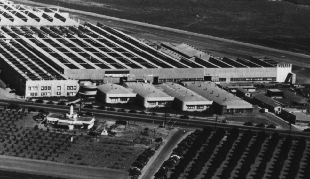 division
of Convair was awarded a $1,2 million contract by the government
to study long-range missile weapons systems. The study was called
project MX-774 and was designed to study two types of missiles:
a subsonic, jet engine cruise missile and a rocket-powered supersonic
ballistic missile. Downey's engineers focused on the ballistic
missile concept and used information about the German V-2 rocket
as a starting point. Although the MX-774 program was eventually
canceled by the Defense department, the Downey Division was developing
numerous other projects including the Y-P1 fighter plane and
components for the huge XP-38 bombers. division
of Convair was awarded a $1,2 million contract by the government
to study long-range missile weapons systems. The study was called
project MX-774 and was designed to study two types of missiles:
a subsonic, jet engine cruise missile and a rocket-powered supersonic
ballistic missile. Downey's engineers focused on the ballistic
missile concept and used information about the German V-2 rocket
as a starting point. Although the MX-774 program was eventually
canceled by the Defense department, the Downey Division was developing
numerous other projects including the Y-P1 fighter plane and
components for the huge XP-38 bombers.
-
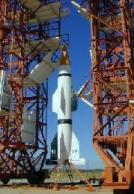 The Vultee plant was also engaged
in the engineering and manufacture of a "guided missile
which carries power equipment providing for travel outside the
atmosphere of the earth. The Vultee plant was also engaged
in the engineering and manufacture of a "guided missile
which carries power equipment providing for travel outside the
atmosphere of the earth.
-
- "Indeed, the MX-774 was described as a "streamlined"
version of the German V-2. The missile was 31 feet, 7 inches
long by 2 feet, 6 inches wide and had a finspan of about 6 feet.
It weighed 1,200 pounds empty". Convair continued ballistic
missile research and design work following the expiration of
the MX-774 project. At the time, U.S. Air Force funding centered
around more conventional winged cruise missile applications,
most notably the Navajo, built by North American".
 The NA-704/XSSM-A-2 proto-Navaho (Air Force
designation MX-770) was a very impressive vehicle that represented
the US rocket design state of the art in 1947-8. It was a lengthened
V-2 with extra tankage for ramjet fuel and numerous structural
improvements, giving the missile five times the range of a standard
V-2. Guidance technology equal to such an advanced airframe was
years in the future The NA-704/XSSM-A-2 proto-Navaho (Air Force
designation MX-770) was a very impressive vehicle that represented
the US rocket design state of the art in 1947-8. It was a lengthened
V-2 with extra tankage for ramjet fuel and numerous structural
improvements, giving the missile five times the range of a standard
V-2. Guidance technology equal to such an advanced airframe was
years in the future
- 1948-1953 Convair was only one of many aircraft manufactures
in America challenged by the post-World War II economic
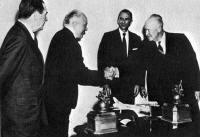 slump. A few miles away from
Downey, in Inglewood, North American Aviation had more than 90
percent of its 8,000 aircraft order cancelled within 24 hours
of the Japanese surrender in 1945. North American turned its
focus toward jet aircraft, supersonic aerodynamics, and rocket
propulsion. Like Convair, North American saw the future in long-range
missile technology and based their research on the German V-2
rocket used in World War II. North American was headed by James
Howard "Dutch" Kindelberger . Lee Atwood was Dutch's
assistant . North American aircraft included the FJ-1 Fury, F-86
Sabre jet, and the B-45 Tornado. Kindelberger had been chief
engineer for Donald Douglas, creating the famous DC-2 and 3.
planes. Photo right, Dutch Kindelberger receives Collier Trophy
from Eisenhower slump. A few miles away from
Downey, in Inglewood, North American Aviation had more than 90
percent of its 8,000 aircraft order cancelled within 24 hours
of the Japanese surrender in 1945. North American turned its
focus toward jet aircraft, supersonic aerodynamics, and rocket
propulsion. Like Convair, North American saw the future in long-range
missile technology and based their research on the German V-2
rocket used in World War II. North American was headed by James
Howard "Dutch" Kindelberger . Lee Atwood was Dutch's
assistant . North American aircraft included the FJ-1 Fury, F-86
Sabre jet, and the B-45 Tornado. Kindelberger had been chief
engineer for Donald Douglas, creating the famous DC-2 and 3.
planes. Photo right, Dutch Kindelberger receives Collier Trophy
from Eisenhower
-
- Convair - Vultee Deal Confirmed
- Consolidated Chief Will Have Advisory Position After
Merger
from the San Diego Union, November 26, 1941, page 1
Formal confirmation of reports that the comparatively small Vultee
Aircraft Inc., of Downey plans to take control of the huge Consolidated
Aircraft Corp. of San Diego was given yesterday afternoon in
a joint statement by the companies. The statement asserted the
deal had not been completed, but indicated that, when it is consummated,
Maj. Reuben H. Fleet, Consair president, would be retained In
an advisory capacity for a time.
-
- Issued after a day in which the companies at first refused
comment, then denied knowledge of merger plans, the statement
is as follows: "Of our own volition, we have for some time
been mutually exploring the business aspects of a possible future
association of our companies. The facilities, products, proximity
of location and experience of Consolidated and Vultee so complement
each other as to make possible the more expeditious completion
of their defense assignments. However, the initial steps of this
transaction, the terms of which are not fully agreed upon, contemplate
the purchase by Vultee Aircraft, Inc., of the Consolidated stock
holdings of Maj. Fleet and others. The present negotiations are
between Vultee and Maj. Fleet as an Individual and not with Consolidated
as a corporation. In the event the transaction is consummated,
it would be the desire that the extensive knowledge and long
experience of Maj. Fleet be made available in an advisory capacity
for a substantial period of time. Any other statements are premature
and were not authorized by either party."
-
- The first paragraph of the statement was taken by observers
as an effort to refute intimations that the move had been inspired
by a war department desire "to effect a change in management"
at Consair.
-
- News of the Vultee-Fleet deal came over the wires in advance
notices of a story the American Aviation Daily planned to print
at Washington. Confronted with the story, a Vultee spokesman
early yesterday morning said the deal was under way. Consair
officials steadfastly denied any knowledge of the transaction,
while Maj. Fleet was reported "unavailable" for comment
on reports that he and members of his family had sold their stock
holdings to Vultee for $10,000,000. Later Vultee asserted the
company spokesman who had issued the "premature" confirmation
of the merger had been discharged. While there were no official
reports on financial powers behind the merger plan, It was rumored
in aircraft circles that Tom Girdler, chairmen of the board of
the Republic Steel Corp., might be interested in the transaction.
-
- Another name mentioned was that of Victor Emanuel, New York
investment banker, director of Vultee and Republic and a navy
pilot during the World war. Meanwhile reports were current in
local aircraft circles that Girdler was at Downey or on the way
there in connection with the big aircraft deal. Talk of such
a transaction has been heard in financial circles in Los Angeles
and in Washington for weeks one authority said. Vultee was prepared
to take over the huge Consolidated plant Dec. 1.
-
- He said Vultee was purchasing the 348,822 shares of Consair
stock owned by Maj. Fleet and an undisclosed number of shares
held by other members of the Fleet family.. Consolidated's common
stock totals 1,291,574 shares. We added that the purchase would
give Vultee control of Consair.
-
- Consolidated has $750,000,000 in orders from the United States
and British governments for multi-engined bombers. Vultee has
$162,000,000 in orders from the United States, Peru and China
for training planes. W. J. Chudleigh, president of Aircraft Local
1125 of the A.F.L. Machinists union, which holds bargaining rights
for most of Consair's 30,000 workers, said the contract between
his union and the plane plant would continue if there is a change
in management. He said that, while Vultee at Downey has a labor
contract with the C.I.O. United Auto Workers, a Vultee plant
in the east has an A.F.L. contract. The Consair-A.F.L. contract
expires May 27, 1943, or at the end of President Roosevelt's
unlimited national emergency, whichever is shorter.
-
- The company now planning to obtain control of Consair is
named after the late Jerry Vultee, aircraft designer, who founded
the company, but who died in an air crash three years ago while
honeymooning in Arizona. Following reorganization two years ago,
Vultee began expanding. A year ago it increase its facilities
by a merger with the Stinson Co., which had plants in Tennessee
and Michigan. Its Downey plant employs 10,000 workers. Its president
is Richard W. Miller. Consair was formed in East Greenwich, R.
I., and moved to Buffalo N. Y. in 1924, and came to San Diego
in 1935.
-
- Developer of the quantity-production B-24 bomber known to
the British as the Liberator, and the PBY navy patrol plane,
called the Catalina by the British, Consair is one of the largest
airplane factories in the world. Its home plant is estimated
to have cost $20,000,000, while a $20,000,000 estimate also has
been placed on a recently completed parts plant. In addition
the company has a contract to provide management for a huge plant
at Ft. Worth, Tex., designed to build B-24 bombers from parts
manufactured by Henry Ford in Ypsilanti, Mich.
|
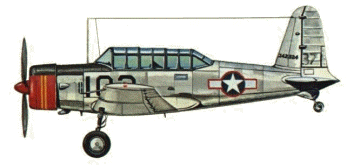 Home
Home |

